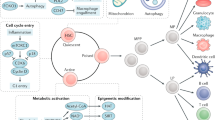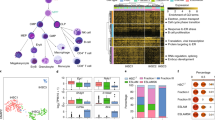Abstract
The spleen colony assay of Till and McCulloch1, which is a clonal assay2, is considered to be a measure of the stem cell content of haematopoietic tissue. Stem cells are a heterogeneous population3–6 with respect to their capacity to generate further stem cells (assayed as colony-forming units in spleen, CFU-S) and progenitors of red cells, granulocytes, macrophages and platelets. It has been suggested that stem cells are organised for use according to their generation age5,6. There is evidence to indicate that drugs such as hydroxyurea (HU) and 5-fluorouracil (5-FU), which preferentially eliminate proliferating cells, spare non-cycling stem cells which have a high capacity to generate other stem cells6 and progenitors of granulocytes and macrophages6 as well as megakaryocytes7. We show here, however, that the CFU-S content of haematopoietic tissue is not an adequate predictor of the capacity of that tissue to repopulate bone marrow of a lethally irradiated host. Furthermore it appears that haematopoietic stem cells are not only heterogeneous with respect to their capacity to generate other stem cells and progenitors of haemic cells in the spleen but also differ in their capacity to ‘home’ to either the bone marrow or spleen. The evidence suggests a class of ‘primitive’ haematopoietic stem cell (pre-CFU-S) that accumulates in the bone marrow to give rise to cells capable of growing in spleen.
This is a preview of subscription content, access via your institution
Access options
Subscribe to this journal
Receive 51 print issues and online access
$199.00 per year
only $3.90 per issue
Buy this article
- Purchase on Springer Link
- Instant access to full article PDF
Prices may be subject to local taxes which are calculated during checkout
Similar content being viewed by others
References
Till, J. E. & McCulloch, E. A. Radiat. Res. 14, 213–222 (1961).
Becker, A. J., McCulloch, E. A. & Till, J. E. Nature 197, 452–454 (1963).
Micklem, H. A. & Ogden, D. A. in Stem Cells (eds Cairnie, A. B., Lala, S. K. & Osmond, D. G.) 331–341 (Academic, New York, 1976).
Botnick, L., Hannon, E. & Hellman, S. Blood Cells (in the press).
Rosendaal, M., Hodgson, G. S. & Bradley, T. R. Nature 264, 68–69 (1976).
Rosendaal, M., Hodgson, G. S. & Bradley, T. R. Cell Tissue Kinet. 12, 17–29 (1979).
Jones, B., Radley, J., Bradley, T. R. & Hodgson, G. S. Expl Haemat. (in the press).
Trentin, J. J., Curry, J. L., Wolf, W. & Cheng, W. in The Proliferation and Spread of Neoplastic Cells, 713–731 (Williams and Wilkins, Baltimore, 1968).
Bradley, T. R., Hodgson, G. S. & Rosendaal, M. J. cell Physiol. 97, 517–522 (1978).
Bradley, T. R. & Hodgson, G. S. in Experimental Hematology Today (eds Baum, S. & Ledney, G.) (Springer, Berlin, in the press).
Author information
Authors and Affiliations
Rights and permissions
About this article
Cite this article
Hodgson, G., Bradley, T. Properties of haematopoietic stem cells surviving 5-fluorouracil treatment: evidence for a pre-CFU-S cell?. Nature 281, 381–382 (1979). https://doi.org/10.1038/281381a0
Received:
Accepted:
Published:
Issue Date:
DOI: https://doi.org/10.1038/281381a0
This article is cited by
-
The evolution of hematopoietic cells under cancer therapy
Nature Communications (2021)
-
Haematopoietic stem cells: past, present and future
Cell Death Discovery (2017)
-
Delineating the effects of 5-fluorouracil and follicle-stimulating hormone on mouse bone marrow stem/progenitor cells
Stem Cell Research & Therapy (2016)
-
25 Years of Epidermal Stem Cell Research
Journal of Investigative Dermatology (2012)
-
Identification and location of label retaining cells in mouse liver
Journal of Gastroenterology (2010)
Comments
By submitting a comment you agree to abide by our Terms and Community Guidelines. If you find something abusive or that does not comply with our terms or guidelines please flag it as inappropriate.



